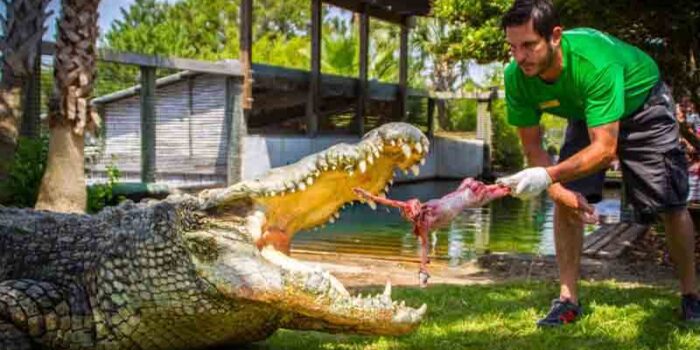Crocodiles belong to the class Reptilia and live in tropical regions i.e. Africa, Asia, America, and Australia. They are bigger animals but still, they face the problem of big fish stories and over-exaggeration. Here is the list of the largest crocodiles in the world:
1. Gomek (5.42 meters/17.78 Feet)
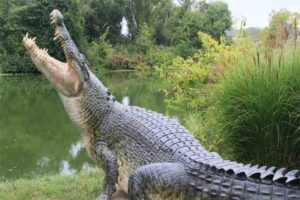
Gomek was the seawater crocodile measuring 17.78 feet long and weighing 860 kgs (1896 lb). George Craig captured it in New Guinea. He was bought by Terri and Arthur Jones in 1985 and was kept in Ocala Florida for five years then it was sold to St. Augustine Alligator Farm Zoological Park in Florida. For 8 years he wowed audiences with both his wonderful nutria-tossing abilities and his even more remarkable acceptance of people. Feeders used large tongs to feed Gomek, he was generally known to be a “tame” crocodile and was the favorite of the Alligator farm and people around the nation.
Gomek was died by heart disease on March 6, 1997. At that time, he was a very old crocodile and one of the largest and tamest captive crocodiles in existence. When he died, his length was 5.42 meters (17.8 ft) and weight was 860 kg (1896 pounds) – as confirmed by St. Augustine Alligator Farm – and possibly between 60 and 80 years old. There is a compliment to Gomek near his arena, which now houses his successor Maximo and his mate Sydney.
Current status: dead
Read also: 10 Largest Birds You Should Not Miss
2. Cassius (5.48 meters/17 feet 11 in)
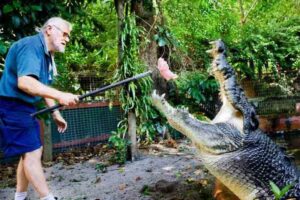
This Australian saltwater giant has been claimed as the largest crocodile seized in captivity and was known by the Guinness World Records as the world’s largest crocodile in captivity in 2011. He is missing his front left leg and the tip of his tail due to venomous fights. He exists in Marineland Melanesia on Green Island in Australia. He was caught in 1987 by Mr. Craig in the Finis River in the Northern Territory after attacking boats and causing annoyance. After the capture of Cassius, Mr. Craig spent 30 years with the gigantic reptile and fed him every day.
Cassius is 5.48 meters (17 feet 11 in) long and is thought to be around 110 years old. It is named after Cassius Clay, the natal name of boxer Muhammad Ali (January 17, 1942 – June 3, 2016).
Current status: alive
Read also: 10 Deadliest Fishes that can be dangerous for humans
3. Utan (5.5 meters/18 feet)
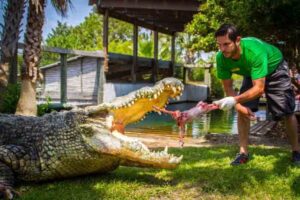
Utan at present lives in Alligator Adventure, one of the World’s biggest reptilian facilities. Utan is a crossbreed between saltwater and Siamese crocodile. He was born in 1964, weighs like 2000 lbs, and is just over 18 ft in length. Utan is found at Samut Prakan crocodile farm, which is almost twelve miles outside of Bangkok, Thailand. He was named by the name of the farm owner’s son, Utan Young Prapakarn. He currently lives in Alligator Adventure, a reptilian facility located next to Barefoot Landing in North Myrtle Beach, one of South Carolina’s most amazing tourist attractions.
Although Utan’s bite force has never been experienced, it is said to be estimated at about 5000 lbs. of weight per square inch, more than two tons!
Current status: alive
Read also: 10 Most Romantic Animals in the World
4. Brutus (5.60 meters/18 feet 4 in)
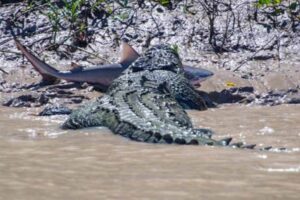
Brutus the massive crocodile is a tourist attraction on the Adelaide River in Australia. This gigantic saltwater crocodile named “Brutus” has only three limbs! It is recognized to frequent the Adelaide River, Northern Territory, Australia. Brutus is misplaced his front leg following what is believed to have been a confrontation with a bull shark in the river’s estuary – leaving many people to wonder just how big the shark was.
Brutus is conventionally estimated at 5.6 meters (18 feet 4 in) and weighing about a ton.
Current status: alive
Read also: Top Animals with Longest Gestation Period
5. Bujang Senang (5.88 meters/19 feet 3 inches)
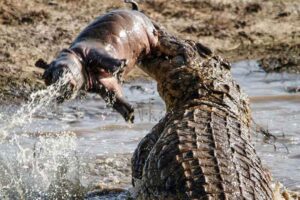
Bujang Senang was a gigantic saltwater crocodile and it was living in Borneo. According to the native sources, he was a man-eater (some people even claimed that he had been around and killed for at least thirty years). Initially, he was estimated at 25 feet (7.62 meters).
Bujang Senang was killed on May 20, 1992. After the kill, it turned out that his length was miscalculated. He was 19 feet 3 inches in length (5.88 meters) and weighed over a ton. The skull of Bujang Senang is placed at the Sarawak Museum (Kuching, Malaysia).
Current status: dead
Read also: Top 10 Smallest Cat Breeds In the World
6. Gustave (~6 meters/19.68 feet)
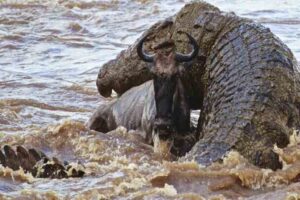
The most terrifying beast ever is a man-eater named “Gustave”. It is a large male Nile crocodile from Burundi and is thought to have killed as many as 300 humans from the banks of the Ruzizi River and the northern coasts of Lake Tanganyika.
A herpetologist Patrice Faye, who has been learning and inspecting him since the late 1990s gave it the name Gustave. Most knowledge about Gustave stems from the film Capturing the Killer Croc, which aired in 2004 on PBS. The film documents a capture effort and study of Gustave.
Gustave has not been captured so his exact length and weight are indefinite. In 2002 it was stated that he might be “merely more than 20 feet (6 meters) long”, and weigh more than a ton. Some estimations have put Gustave at 7.5 meters (25 feet) or more in length. When first witnessed, he was estimated to be around 100 years old in order to achieve such outstanding size; however, Gustave revealed a complete set of teeth when he opened his mouth. According to the documentary a 100-year-old crocodile “should be approximately toothless” so, he was estimated to be “probably no older than 60 and likely, still growing”.
Gustave has three bullet scars on his body. His right shoulder blade was also found to be intensely wounded. Circumstances surrounding the four scars are indefinite. Herpetologists who have studied Gustave claim that his unusual size and weight impede his capability to hunt the species’ usual, agile prey such as fish, antelope, and zebra, forcing him to attack larger animals such as hippopotamus and, to some extent, humans. According to a native warning, he is said to hunt and leave his victims’ corpses uneaten. Also, it was stated in his documentary film that since crocodiles can go a number of months without eating, one the size of Gustave could afford to select his prey carefully.
Gustave was last time sighted in February 2008 by National Geographic sources. According to Wikipedia, one resident claimed that Gustave dragged an adult bull buffalo on a riverbank, in June 2015. That claim is under “citation needed” status.
National Geographic Channel created a documentary with the title of “Capturing the Killer Croc” which followed a team led by Patrice Faye that tried to capture Gustave but was unable to do so.
Current status: unknown, probably alive
Read also: Top 10 Largest Cat Breeds in the World
7. Dominator (6.1 meters/20 feet)
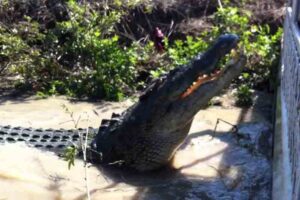
Dominator, the marine water giant has never been publicly measured but it is estimated that he measures up to 20 feet (6.1 meters) and weighs over a ton. He shares the same zone with another saltwater giant Brutus (Adelaide River, Northern Territory, Australia).
Current status: alive
Read also: 10 Most Dangerous Bugs in the world
8. Lolong (6.17 meters/20 feet 3 in)
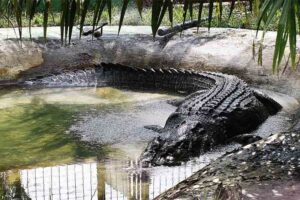
Lolong measured as 20 ft 3 in (6.17 m), and weighed 2,370 lbs (1,075 kg), Lolong was the largest crocodile in captivity and also the largest crocodile ever measured from snout-to-tail.
Lolong was an Indo-Pacific or marine water crocodile (Crocodylus porosus). Australian crocodile expert Dr. Adam Britton measured Lolong in his arena in November 2011 and confirmed him as the world’s longest crocodile ever caught and placed in captivity.
He was trapped in a Bunawan creek in the province of Agusan del Sur in the Philippines on 13 September 2011. He was netted with the joint cooperation of the resident government unit, residents, and crocodile hunters of Palawan. The giant crocodile was captured over a period of three weeks; once it was found, it took around 100 people to carry him onto land. He became violent at several points during the capture and twice broke preventive ropes. He was expected to be at least 50 years old.
Lolong was supposed to eat a fisherman who went lost in the town of Bunawan and also consumed a 12-year-old girl whose head was found two years earlier. He was also the primary suspect in the missing seahorses in the area. In the examination of the stomach substances after his capture, remnants of water buffaloes reported missing before Lolong’s capture were found, but there were no human remains.
The crocodile was named after Ernesto “Lolong” Goloran Cañete, one of the veteran crocodile hunters from the Palawan Crocodile and Wildlife Reservation Center, who led the hunt. After weeks of trailing, the hunt for Lolong took its toll on Cañete’s health. He died by a heart attack some days before the crocodile was captured.
Lolong was reported dead in captivity just 18 months far along he was captured, at around 8 pm on 10 February 2013. His necropsy revealed that he died from congestive heart failure compounded by fungal pneumonia, lipidosis of the liver and kidney failure.
Current status: dead
Read also: Top 10 Fastest Birds In The World
9. Kalia (Bhitarkanika Park crocodile) (claimed size: 7.01 meters/23 feet) Largest Crocodiles
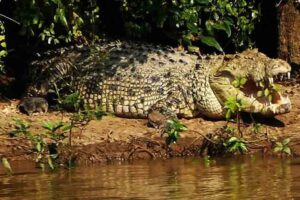
It gives the impression the Guinness World Record book has accepted a claim that a 23 ft (7.01 meters) giant male saltwater (named Kalia) crocodile weighing 2,000 kg lives within (Bhitarkanika Park) the state of Orissa, India, but because of the problem in capturing such a large monster, the precision of the measurement is yet to be verified. There’s also no photo at yet.
Current status: alive
Read also: 10 Fastest Dog Breeds in the World
10. Krys
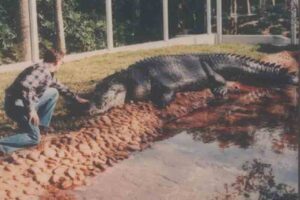
According to a story, a massive crocodile was shot in July 1958 near Normanton, Queensland, Australia. It was named Krys after the person who shot it. It was supposed as 28 foot 4 inches (8.64 meters). The claimed size of Krys is highly mysterious because it is much larger than any other precisely reported measurements.
The replica of Krys was placed at Normanton, Queensland, Australia. The claimed size of Krys is highly mysterious because it is much larger than any other accurately reported measurements. And, probably, this “life-size replica” isn’t very precise, too. Zoologist and crocodile expert Adam Britton sedated the replica’s head in June 2017 and found that its head-body ratio is not appropriate. Krys the Crocodile statue in Normanton, is supposedly a life-size representation of a 28 ft (8.6 m) saltwater croc that Krys Pawlowski shot on the Norman River.
Current Status: dead
11. Saltwater crocodiles

The saltwater crocodile is the largest reptile on Earth. Males average 17 feet and 1,000 pounds, with some reaching 23 feet and 2,200 pounds. They can live for several decades, with an average lifespan of 70 years. Saltwater crocodiles prefer to live in Southeast Asia and Australia, usually near coasts or rivers with a mix of fresh and salty water. Saltwater crocodiles are patient hunters, hiding by the water. They grab animals like water buffalo and monkeys, quickly pulling them underwater to eat.
12. Nile Crocodile

In African rivers and lakes, the Nile is the largest crocodile that grows up to 20 feet long and weighs around 1,650 pounds, but most are about 16 feet and 500 pounds. Nile crocodiles were almost all gone in the 1940s to 1960s because of hunting, but rules to protect them have helped them come back in many places. However, in some areas, there are still fewer crocodiles because of pollution, hunting, and losing their homes. Nile is one of the most dangerous reptiles in the world. They quietly wait near the water and suddenly grab and drown their prey.
13. Orinoco Crocodile

Orinoco crocodiles live in the Orinoco River area in Colombia and Venezuela. They stay together in groups and can be really heavy, with some of the big males weighing over 2,000 pounds. People hunt Orinoco crocodiles for their meat and teeth, which are used for medicine. They face problems like losing their homes, eggs being taken, and competition with other animals. The exact population is unclear, estimated between 250 to 1,500, but they are in danger, and their population is going down. These crocodiles help keep their environment healthy by eating different animals.
14. Black Caiman

The black caiman is the biggest alligator in the Amazon River, about 4 meters(13.1 feet) in length. Its black skin helps it hide during night hunts. People almost killed them all for their valuable skin. They enjoy warmth and sunbathing with open mouths. While not the meanest, they can get protective and have attacked over 80 people in the last 20 years. These caimans rule the food chain, eating many animals and being hard to spot at night. They were almost gone because of hunting, but now there are more. They live in the Amazon Basin and are important for keeping the environment healthy. They’re big, act in interesting ways, and are tough survivors.
15. American Alligators

American alligators are big reptiles found only in the United States. They can be longer than 12 feet and weigh up to 1,000 pounds. With dark, scaly skin and a strong tail, they move well in the water. Alligators usually have 74 to 80 teeth at once, and when these wear out, new ones replace them. Throughout their life, an alligator can go through 3,000 teeth. They like warm places, often sunbathing or floating in water like logs. Living in the Southeast, they stay in rivers, swamps, and lakes, eating fish, frogs, birds, and mammals using powerful jaws to crack shells. Alligators walk in a unique way and rest when it’s too hot or cold.
16. Gharials

Gharials are long-snouted Asian crocodiles found in India and Nepal. They grow up to 15 feet and weigh around 2,000 pounds. They like to regulate their body temperature by sunbathing or resting in the shade or water. Male gharials have a growth on their snout called a “ghara” used for making sounds during mating.
These largest crocodiles are in danger, with a 98% decline since the 1940s, mainly due to hunting, habitat changes, and getting caught in fishing nets. Conservation efforts involve protection, reintroduction programs, and habitat restoration, but it’s uncertain how well they’re working. Gharials primarily eat fish and are adapted for life in the water.
17. False Gharial

The false gharial, a water-adapted reptile, grows up to 18 feet, males being larger, and weighs 205 to 463 pounds. With brown scales on top, black patches, and a lighter underside, they’re ambush predators, waiting in the water for prey like fish, amphibians, reptiles, crustaceans, and mammals. Courtship and mating occur from November to March, with females laying 20 to 60 eggs in nests.
Eggs face threats from snakes, monitor lizards, wild pigs, and human collection. Sexual maturity is reached at 8.2–9.8 feet and age 20. They may live up to 80 years in the wild. Compared to the gavial, the false gharial differs in snout shape, teeth number (76–84 vs. 110), and geographic range, lacking the bulbous protrusion found in the gavial’s snout.
18. Slender-Snouted Crocodile

The slender-snouted crocodile is a shy freshwater species with a slender snout, reaching up to about 4 meters in length. It displays captivating shades of olive with large, dark brown blotches on its body. These crocodiles prefer living in secluded areas like heavily forested rivers and wetlands. During the wet season, females lay over 15 eggs in mound nests, and their vocal nature is notable. They are found in western tropical Africa, favoring habitats with dense vegetation surrounded by forests. In the wild, their diet mainly consists of fish, while in captivity, they are fed a mix of fish, small mammals, birds, and prepared crocodilian diets.
19. Mugger Crocodile

The mugger crocodile is a medium to large-sized crocodile with the widest snout among living crocodiles. It lives in the Indian subcontinent and surrounding areas. With a flat head and eyes, ears, and nose on top, it can see, hear, and breathe above water while submerged. Evolving over 4.19 million years, it has been a symbol of river forces since ancient times. Described scientifically in 1831, it is legally protected in Iran, India, and Sri Lanka. Muggers have a powerful tail and webbed feet. They prefer shallow waters and adapt to various habitats, including lakes, marshes, ponds, and coastal lagoons.
20. American Crocodile

The American crocodile, found across North, Central, and South America, faces endangerment due to illegal hunting and habitat loss. Limited survey data shows a critical decline in its population. While some remain in southern Florida, the majority live in southern Mexico, Central America, the Caribbean, and northern South America.
Preferring fresh or brackish water in estuaries, coastal lagoons, and mangrove swamps, it differs from alligators with a longer, thinner snout and visible lower jaw teeth. Among the world’s largest crocodiles, males in Central and South America can reach 20 feet, while U.S. males seldom exceed 13 feet. Their diet includes small mammals, birds, fish, crabs, insects, snails, frogs, and occasional carrion, with rare attacks on humans.
Read also: Top 10 smallest dog breeds in the world
